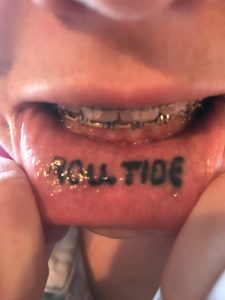 UA Anthropology graduate student Mackenzie Manns (Photo courtesy M. Manns).[/caption] UA Anthropology graduate student Mackenzie Manns (Photo courtesy M. Manns).[/caption]
Do my tattoos make me look more fit, or fit at all? Gosh, I hope so. Look over here at my guns—er, arms---and not at the middle age gut I’m fighting to suck in. In a study of 6528 undergraduates we conducted nationwide, we found that tattooing may be used by those who are generally more fit, especially among men, to highlight that fact. There is extensive ethnographic literature suggesting that tattoos are signs of status and social roles. They indicate marital status, age, success in life, affiliation, and so on. But contemporary tattooing seems so dispersed and idiosyncratic—do those same motivations still apply in today’s world? In 2012, Rachael Carmen, Mandy Guitar, and Haley Dillon suggested tattoos (and piercing, but we’ll come back to that) fit two evolutionary patterns of behavior—these body modifications may indicate our affiliations with successful groups or injure our bodies so we can heal and show off our healthy immune systems. In 2016, Cassie Medeiros and I wondered if media portrayals of tattooed athletes amplified that signal out of proportion—in other words, are there really so many tattooed athletes or do they just get the most press: ...Or both, in a positive feedback cycle? ...Or are fans more likely to get sports tattoos? After all, athletes at the intercollegiate or professional level are already obviously highly fit people, for the most part, and being recognized for such through through athletic performances---especially if they win! Maybe it’s the folks who aren’t on the teams getting all the ESPN attention who need to shout, "Hey look at MY hot bod!" Or, "Yes, I AM the 12th (hu)man responsible for the decade of football success at the Alabama, as you can see from my 'Roll Tide' tattoo." We tested these hypotheses in two online studies, asking undergraduates if they were tattooed, pierced, athletes, had any college or pro sport-related tattoos, and had ever had any related medical complications. The first study was a national study of 524 respondents but was inconclusive because of the low number of intercollegiate athletes who responded. For the second study, we surveyed all 31,000+ University of Alabama undergraduates and received 6004 usable responses, including 50% of UA’s 572 student athletes and 31 of our national championship (ahem, repeated championship) football team. Here's what we found:
0 Comments
Leave a Reply. |
Christopher D. LynnI am a Professor of Anthropology at the University of Alabama with expertise in biocultural medical anthropology. Archives
May 2023
Categories
All
|

 RSS Feed
RSS Feed
